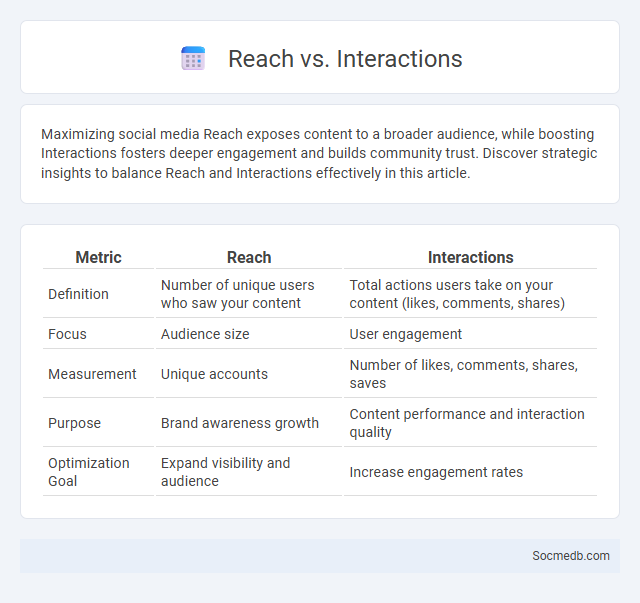
Photo illustration: Reach vs Interactions
Maximizing social media Reach exposes content to a broader audience, while boosting Interactions fosters deeper engagement and builds community trust. Discover strategic insights to balance Reach and Interactions effectively in this article.
Table of Comparison
| Metric | Reach | Interactions |
|---|---|---|
| Definition | Number of unique users who saw your content | Total actions users take on your content (likes, comments, shares) |
| Focus | Audience size | User engagement |
| Measurement | Unique accounts | Number of likes, comments, shares, saves |
| Purpose | Brand awareness growth | Content performance and interaction quality |
| Optimization Goal | Expand visibility and audience | Increase engagement rates |
Understanding the Basics: What is Reach?
Reach in social media refers to the total number of unique users who have seen a particular piece of content. It measures the spread and visibility of posts across platforms like Facebook, Instagram, and Twitter, providing insights into audience size and engagement potential. Understanding reach helps marketers optimize content strategies to maximize brand exposure and influence.
Defining Interactions: Key Metrics Explained
Social media interactions encompass likes, comments, shares, and clicks, serving as primary metrics to measure user engagement and content effectiveness. Understanding these key metrics allows businesses to analyze audience behavior, optimize content strategies, and increase brand visibility. Tracking interaction rates alongside reach and impressions provides a comprehensive view of social media performance and audience connection.
Reach vs Interactions: Core Distinctions
Reach measures the total number of unique users who see your social media content, while interactions track the engagement these users have with your posts, such as likes, comments, and shares. Focusing on increasing reach helps expand your brand awareness across a broader audience, whereas prioritizing interactions boosts relationship building and loyalty among your current followers. Understanding the balance between reach and interactions allows you to optimize your content strategy effectively for growth and engagement.
Why Reach Matters in Digital Marketing
Achieving a broad reach on social media ensures your content is seen by a larger, more diverse audience, directly impacting brand awareness and potential customer acquisition. Your reach determines the scale at which your marketing campaigns influence user behavior and engagement rates, driving conversion opportunities. Understanding why reach matters helps you strategically allocate resources to optimize visibility and maximize return on investment in digital marketing efforts.
Measuring Interactions: What Should You Track?
Track metrics such as engagement rate, including likes, comments, shares, and saves, to evaluate audience interaction with content. Monitor click-through rates (CTR) and conversion rates to assess effectiveness in driving traffic and achieving marketing goals. Analyze follower growth and audience demographics to tailor content strategies and optimize future social media campaigns.
How Reach and Interactions Influence Engagement
Reach determines how many people see your social media content, directly impacting the potential audience size for interactions such as likes, comments, and shares. Interactions signal content relevance and quality to algorithms, boosting visibility and driving further engagement. Maximizing both reach and interactions is essential for increasing your social media engagement and growing an active, interested community.
Optimizing Content for Maximum Reach
Optimizing content for maximum reach on social media involves leveraging platform-specific algorithms by using relevant hashtags, engaging visuals, and peak posting times to boost visibility. Crafting concise, compelling captions paired with interactive elements like polls or questions encourages audience interaction, which further amplifies organic reach. Analyzing performance metrics such as engagement rates and click-through statistics helps refine content strategy for continuous improvement and targeted audience growth.
Boosting Interactions: Proven Strategies
Boosting interactions on social media platforms requires targeted strategies such as leveraging engaging content formats like videos, live streams, and interactive polls to increase user participation. Utilizing data analytics tools enables precise audience segmentation and personalized messaging, enhancing relevance and engagement rates. Consistent posting schedules combined with active community management foster loyal followers and stimulate organic conversations across channels like Instagram, Facebook, and Twitter.
Reach or Interactions: Which Metric to Prioritize?
Choosing between reach and interactions depends on your marketing goals; reach measures the total number of unique users exposed to your content, while interactions track user engagement such as likes, comments, and shares. Prioritizing interactions is crucial for building community and fostering deeper connections, as these actions reflect active participation rather than passive viewing. You should focus on interactions to maximize the impact of your social media strategy and enhance brand loyalty.
Aligning Campaign Goals: Reach vs Interactions
Aligning campaign goals between reach and interactions is crucial for optimizing social media marketing strategies. Reach maximizes the number of unique users exposed to content, ideal for brand awareness, while interactions measure engagement such as likes, comments, and shares, indicating deeper audience connection. Prioritizing these objectives based on campaign purpose enhances targeted results and return on investment (ROI).
 socmedb.com
socmedb.com